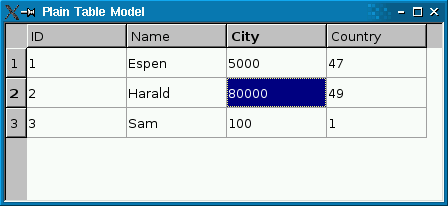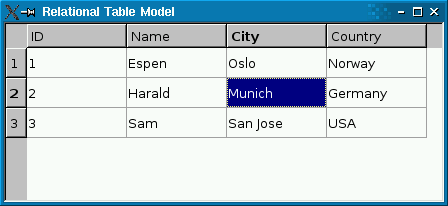Using the SQL Model Classes |
| QSqlQueryModel | A read-only model based on an arbitrary SQL query. |
| QSqlTableModel | A read-write model that works on a single table. |
| QSqlRelationalTableModel | A QSqlTableModel subclass with foreign key support. |
These classes derive from QAbstractTableModel (which in turn inherits from QAbstractItemModel) and make it easy to present data from a database in an item view class such as QListView and QTableView. This is explained in detail in the Presenting Data in a Table View section.
Another advantage of using these classes is that it can make your code easier to adapt to other data sources. For example, if you use QSqlTableModel and later decide to use XML files to store data instead of a database, it is essentially just a matter of replacing one data model with another.
The SQL Query Model
QSqlQueryModel offers a read-only model based on an SQL query.
Example:
QSqlQueryModel model;
model.setQuery("SELECT * FROM employee");
for (int i = 0; i < model.rowCount(); ++i) {
int id = model.record(i).value("id").toInt();
QString name = model.record(i).value("name").toString();
qDebug() << id << name;
}
After setting the query using QSqlQueryModel::setQuery(), you can use QSqlQueryModel::record(int) to access the individual records. You can also use QSqlQueryModel::data() and any of the other functions inherited from QAbstractItemModel.
There's also a setQuery() overload that takes a QSqlQuery object and operates on its result set. This enables you to use any features of QSqlQuery to set up the query (e.g., prepared queries).
The SQL Table Model
QSqlTableModel offers a read-write model that works on a single SQL table at a time.
Example:
QSqlTableModel model;
model.setTable("employee");
model.setFilter("salary > 50000");
model.setSort(2, Qt::DescendingOrder);
model.select();
for (int i = 0; i < model.rowCount(); ++i) {
QString name = model.record(i).value("name").toString();
int salary = model.record(i).value("salary").toInt();
qDebug() << name << salary;
}
QSqlTableModel is a high-level alternative to QSqlQuery for navigating and modifying individual SQL tables. It typically results in less code and requires no knowledge of SQL syntax.
Use QSqlTableModel::record() to retrieve a row in the table, and QSqlTableModel::setRecord() to modify the row. For example, the following code will increase every employee's salary by 10 per cent:
for (int i = 0; i < model.rowCount(); ++i) {
QSqlRecord record = model.record(i);
double salary = record.value("salary").toInt();
salary *= 1.1;
record.setValue("salary", salary);
model.setRecord(i, record);
}
model.submitAll();
You can also use QSqlTableModel::data() and QSqlTableModel::setData(), which are inherited from QAbstractItemModel, to access the data. For example, here's how to update a record using setData():
model.setData(model.index(row, column), 75000);
model.submitAll();
Here's how to insert a row and populate it:
model.insertRows(row, 1);
model.setData(model.index(row, 0), 1013);
model.setData(model.index(row, 1), "Peter Gordon");
model.setData(model.index(row, 2), 68500);
model.submitAll();
Here's how to delete five consecutive rows:
model.removeRows(row, 5);
model.submitAll();
The first argument to QSqlTableModel::removeRows() is the index of the first row to delete.
When you're finished changing a record, you should always call QSqlTableModel::submitAll() to ensure that the changes are written to the database.
When and whether you actually need to call submitAll() depends on the table's edit strategy. The default strategy is QSqlTableModel::OnRowChange, which specifies that pending changes are applied to the database when the user selects a different row. Other strategies are QSqlTableModel::OnManualSubmit (where all changes are cached in the model until you call submitAll()) and QSqlTableModel::OnFieldChange (where no changes are cached). These are mostly useful when QSqlTableModel is used with a view.
QSqlTableModel::OnFieldChange seems to deliver the promise that you never need to call submitAll() explicitly. There are two pitfalls, though:
- Without any caching, performance may drop significantly.
- If you modify a primary key, the record might slip through your fingers while you are trying to populate it.
The SQL Relational Table Model
QSqlRelationalTableModel extends QSqlTableModel to provide support for foreign keys. A foreign key is a 1-to-1 mapping between a field in one table and the primary key field of another table. For example, if a book table has a field called authorid that refers to the author table's id field, we say that authorid is a foreign key.
 |  |
The screenshot on the left shows a plain QSqlTableModel in a QTableView. Foreign keys (city and country) aren't resolved to human-readable values. The screenshot on the right shows a QSqlRelationalTableModel, with foreign keys resolved into human-readable text strings.
The following code snippet shows how the QSqlRelationalTableModel was set up:
model->setTable("employee");
model->setRelation(2, QSqlRelation("city", "id", "name"));
model->setRelation(3, QSqlRelation("country", "id", "name"));
See the QSqlRelationalTableModel documentation for details.
[Previous: Executing SQL Statements] [SQL Programming] [Next: Presenting Data in a Table View]
Best Of
Actualités les plus lues
- « Quelque chose ne va vraiment pas avec les développeurs "modernes" », un développeur à "l'ancienne" critique la multiplication des bibliothèques 44
- Quelles nouveautés de C++11 Visual C++ doit-il rapidement intégrer ? Donnez-nous votre avis 10
- Créer des applications avec un style Metro avec Qt, exemples en QML et C++, un article du blog Digia traduit par Thibaut Cuvelier 0
- « Quelque chose ne va vraiment pas avec les développeurs "modernes" », un développeur à "l'ancienne" critique la multiplication des bibliothèques 44
- Les développeurs ignorent-ils trop les failles découvertes dans leur code ? Prenez-vous en compte les remarques des autres ? 17
- BlackBerry 10 : premières images du prochain OS de RIM qui devrait intégrer des widgets et des tuiles inspirées de Windows Phone 0
- Quelles nouveautés de C++11 Visual C++ doit-il rapidement intégrer ? Donnez-nous votre avis 10
- Adieu qmake, bienvenue qbs : Qt Building Suite, un outil déclaratif et extensible pour la compilation de projets Qt 17
- La rubrique Qt a besoin de vous ! 1
- La rubrique PyQt/PySide a besoin de vous ! 0

- Linus Torvalds : le "C++ est un langage horrible", en justifiant le choix du C pour le système de gestion de version Git 100
- Comment prendre en compte l'utilisateur dans vos applications ? Pour un développeur, « 90 % des utilisateurs sont des idiots » 229
- Quel est LE livre que tout développeur doit lire absolument ? Celui qui vous a le plus marqué et inspiré 96
- Apple cède et s'engage à payer des droits à Nokia, le conflit des brevets entre les deux firmes s'achève 158
- Nokia porte à nouveau plainte contre Apple pour violation de sept nouveaux brevets 158
- Quel est le code dont vous êtes le plus fier ? Pourquoi l'avez-vous écrit ? Et pourquoi vous a-t-il donné autant de satisfaction ? 83
- Le Draft final de la norme C++ 0X validé 181

Le Qt Developer Network au hasard

Utiliser QML et QtWebKit avec PySide
Communauté
Ressources
- 91 cours et tutoriels Qt
- F.A.Q. Qt : 200 questions et réponses
- 48 Qt Quarterly, 35 Qt Labs et 22 Qt DevNet en français
- 43 outils Qt
- 99 sources Qt
- 26 binaires Qt
- 6 livres Qt et 9 critiques
- La documentation de Qt 4.7 en français : 157 classes, 70 concepts et 24 modules
- 3 certifications Qt
Liens utiles
Contact
- Vous souhaitez rejoindre la rédaction ou proposer un tutoriel, une traduction, une question... ? Postez dans le forum Contribuez ou contactez-nous par MP ou par email (voir en bas de page).
Qt dans le magazine
| Cette page est une traduction d'une page de la documentation de Qt, écrite par Nokia Corporation and/or its subsidiary(-ies). Les éventuels problèmes résultant d'une mauvaise traduction ne sont pas imputables à Nokia. | Qt 4.6 | |
| Copyright © 2012 Developpez LLC. Tous droits réservés Developpez LLC. Aucune reproduction, même partielle, ne peut être faite de ce site et de l'ensemble de son contenu : textes, documents et images sans l'autorisation expresse de Developpez LLC. Sinon, vous encourez selon la loi jusqu'à 3 ans de prison et jusqu'à 300 000 E de dommages et intérêts. Cette page est déposée à la SACD. | ||
| Vous avez déniché une erreur ? Un bug ? Une redirection cassée ? Ou tout autre problème, quel qu'il soit ? Ou bien vous désirez participer à ce projet de traduction ? N'hésitez pas à nous contacter ou par MP ! | ||
Copyright © 2000-2012 - www.developpez.com



















